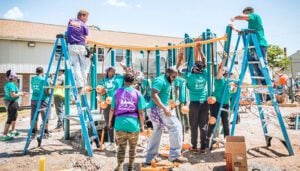At StriveTogether, we’re building civic infrastructure to support every child from cradle to career. That sounds great, but what does it really mean?
Infrastructure holds communities together: roads, bridges, an electricity grid. But there are some connections we can’t see. Relationships, collaboration, goal setting and data sharing are part of infrastructure, too. These pieces are called civic infrastructure.
What do we mean by civic infrastructure?

Civic infrastructure, sometimes called human infrastructure, joins leaders from across a community to work collaboratively, using data, to improve outcomes for children and families.
We define civic infrastructure as the way a region or community comes together to hold itself collectively accountable for implementing its own unique cradle-to-career vision. The community figures out what gets results for children, then improves and expands those efforts over time. The community also invests resources to increase impact.
Civic infrastructure is sometimes called human infrastructure. It joins leaders from across a community — from education, business, health care, housing, philanthropy and more. They work together with community members and use data to improve outcomes for children and families. With these strong connections, communities can change systems and put more young people on a path to economic mobility.
Civic infrastructure is not a program to set up. Rather, it is the organization of all the moving pieces in a community that impact children and their families to more effectively support children from birth to career. So what are those moving pieces, exactly? Let’s take a look at our framework.
Key elements of civic infrastructure
StriveTogether supports communities to create lasting change along our proven framework, the StriveTogether Theory of Action™. The theory of action has four pillars that guide this work:
- Shared community vision | Bringing the whole community together around common goals and holding each other accountable for improvement.
- Evidence-based decision making | Using data to make better decisions, track progress and improve strategies.
- Collaborative action | Supporting community members and leaders to work together effectively.
- Investment and sustainability | Aligning resources behind what we know will work for kids.

Relationships, collaboration, goal setting and data sharing make up a community.
Across the StriveTogether Cradle to Career Network, we’ve seen that communities with these elements in place are getting better outcomes for kids and families.
Interested in seeing what that looks like in communities? Explore stories here.
This blog post was originally published in August 2012 and has been revised to provide updated information.






